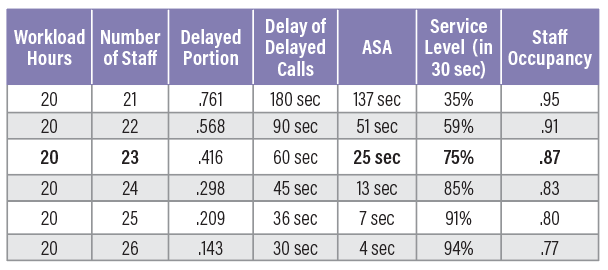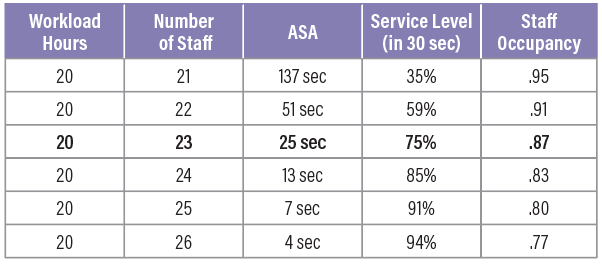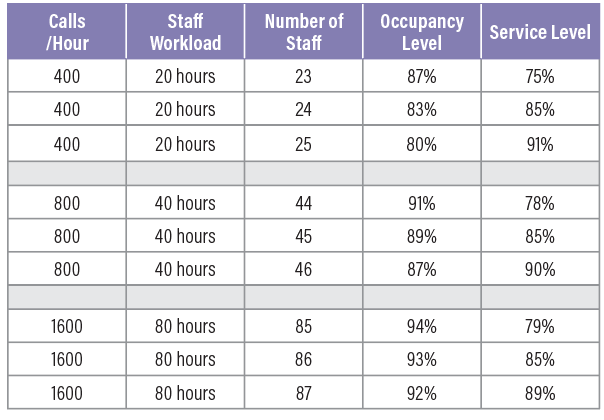Staffing Tradeoffs -Achieving a Balance of Service and Occupancy
By Penny Reynolds
The article in last quarter’s newsletter outlined the steps of calculating workload and discussed various call center staffing models for determining staff requirements for inbound calls, outbound calls, emails, and chat contacts. This article will proceed by examining those staffing calculations in more detail and examining the various numbers and tradeoffs to consider.
Once staffing numbers have been calculated, there will be some fine-tuning of the numbers. This fine-tuning should examine the impact on the call center’s three primary stakeholder groups – the customer, frontline staff, and senior management. In this article we’ll focus on two primary stakeholder groups – the impact of service on the customer and the resulting workload and occupancy experienced by the frontline staff. In the next article, we’ll address the financial concerns of senior management often associated with staffing decisions.
Let’s take a look at a staffing scenario to see the impact of adding or subtracting staff and how it impacts each stakeholder group. First, take a look at what happens to service when staff are added or subtracted. The first table shows some important staffing numbers associated with a workload of 20 erlangs (400 calls per hour with a 3-minute handle time).

On the other hand, if the service situation is one that is problematic to start, with only 22 staff in place for the 20 hours of work and a 51-second ASA, a one-person reduction will make a huge difference. At this point in the service and staffing relationship, the impact of just one person will be alarmingly high – a drop of 24% in service level and an ASA increase of 86 seconds. Let’s begin with a look at the impact of one person when service is very good. In this example, with 20 hours of work and 25 or 26 staff in place, adding or subtracting a person does not make a huge difference. The difference in service level is 3% and the difference in ASA is 3 seconds – not very noticeable to callers. The impact of one more deletion is bigger (6% service level change or 6 seconds ASA increase), but still not significant.
Another way to look at this situation is to take a more positive slant. Note how the situation with 21 people (ASA of 137 seconds or a 35% in 30 seconds service level) realizes a big improvement with the addition of only one person. A person added here looks like a hero by improving delays from 137 to 51 seconds. At this point in the curve, adding just one more person is a powerful action.
Note how the numbers change up and down in the table. While the difference in 25 and 26 staff was a three-second ASA, the difference between 24 and 25 staff is not 3 seconds – it is 6 seconds. And if another person is removed, the incremental change is 12 seconds. There is clearly an exponential change in delay time as staffing levels decrease.
This exponential change is due to the fact that two things happen when staffing levels decrease. First, with each person missing, more callers will have to go into queue. And second, with fewer people available to handle the increasing queue, the wait times become longer. It is this double impact that causes ASA to increase (or service level to decrease) exponentially.
For example, with 25 staff, 20% of calls go into the queue (meaning the other 80% experience no wait) and those that do go into queue wait there for an average of 36 seconds. This weighted average – the 20% that wait 36 seconds and the 80% that wait zero seconds – provides an average wait for all callers of 7 seconds.
When staffing decreases to 24 staff, first the percentage of callers that go into queue increases to almost 30%. And with more people in queue, the wait is longer as there are fewer service providers. The average wait time of queued callers goes from 36 seconds to 45 seconds. This average wait of all calls is the 30% that wait 45 seconds with the 70% with no wait or a weighted average of 13 seconds. You can see that each time that a higher percentage of callers have to go into queue and the wait time gets longer. Therefore, the ASA or service level change is exponential.
This exponential worsening of service happens when the number of staff approaches the hours of erlang workload. Because of the random arrivals of calls, there must be more staff than hours of workload and if not enough over the erlang number, the calls will bunch up in periods of the interval with not enough staff to handle them and the result is a substantial deterioration in service.
The Impact of Size
The example here is relatively small with staff numbers in the twenties. One might think that there is not a significant impact of one person as the size of the center grows to larger numbers. Obviously, one person has a bigger impact on service in a 20-person group compared to a 50-person group. Despite the bigger size, however, a single person can still have a big impact on service, especially if in the dangerous area of the staffing and service curve.
The next table shows some staffing and service relationships with workload and staff numbers doubled and quadrupled. Just like in the 20 hour workload example, there is a significant impact of just one person as staff hours approach hours of workload. The difference between 41 and 42 staff is 88 seconds. And the same is true as the call center size is even bigger. That is why at all sizes it is important to get the just right number of people in place in order to meet service objectives.
Understanding Staff Occupancy
Let’s now take a look at the impact of staffing changes on the next call center stakeholder group – the frontline staff. Staffing changes will impact them by altering the amount of workload each receives and how busy they will be.
Staff occupancy is a measure of how busy agents are handling calls (either in a conversation or in after-call work) versus sitting idle waiting on a call to arrive. It is calculated by dividing workload hours by staff hours.
With 23 staff in place to meet service goals and a workload of 20 hours, the occupancy rate is 87% with 13% of the hour being idle time between calls. If staff are added, each person is less busy with more idle time. On the other hand, if a person is subtracted, occupancy goes from 87% to 91%, meaning idle time between calls during the hour goes from 7.8 minutes to 5.4 minutes – perhaps a noticeable change to agents.
It is important to monitor occupancy to ensure it does not creep up too high. High levels of occupancy over long periods of time can have many detrimental effects, including the following:
- Average handle time (AHT) generally rises. As there is less idle time between calls, staff find a way to avoid the added workload, either by talking longer on an existing call or more likely going into after-call work and staying there longer than necessary.
- Shrinkage increases. With less idle time between calls, staff tend to put themselves in an unavailable state either taking unscheduled breaks or using other activity codes to hide out.
- Stress increases. With a sustained back-to-back workload, there is a higher stress level, resulting in tardiness and absenteeism. If high occupancy continues, staff may leave the company altogether.
- Call quality worsens. As calls build up in queue and wait longer, callers are likely to be upset or angry and therefore more difficult to handle. In addition, staff may feel the pressure of many calls waiting and hurry through necessary elements of the call, lessening overall quality.
Let’s look now at how occupancy is impacted by the size of group or center.
In the first example with 400 calls per hour or 20 hours of workload, staffing to achieve an 85% service level goal would point to 24 staff, resulting in an occupancy rate of 83%. This means that the other 17% of the time, the staff would be idle.
Now look at doubling the workload. With 40 hours of workload, achieving the same service level of 85% in 30 seconds would not take double the staff. Rather than (24 x 2) or 48 staff, only 45 staff are required for this service level and the resulting occupancy is 89%, with 11% idle time.
Now look at doubling the workload again. With 80 hours of workload – four times the original workload – 86 staff are required and the occupancy level is 93%.
The larger the call volume and workload, the more efficient the staff will be at handling it. There are better efficiencies as group size grows with higher and higher occupancy rates. The reason for this is simple. As call volumes increase, there is a greater likelihood that when an agent is finished with a call, there is another one arriving, meaning the agent can be more efficient or more utilized with less idle time between calls.
Obviously, these larger groups and higher occupancy rates are desirable. But they are only desirable up to a certain point. The increased efficiencies that can be gained in very large groups can result in too much workload and burnout of staff. It is important to keep a watch on this number to make sure it doesn’t go unrealistically high for the staff.
In terms of the relationship between service and occupancy, there is an inverse relationship between the two. As staff members are added to improve service, occupancy declines. Likewise, in order to improve occupancy, staff can be removed so that each person is busier and utilized more fully, but service suffers.
The only way to impact both in a positive way is to affect workload. The most common way to accomplish this is via consolidation of small groups into larger ones. In most centers, there are opportunities to consolidate several small groups into one larger one. This is typically accomplished by moving away from specialized skills to a more universal skill set where all calls can funnel into the same group.
The Consolidation Effect
In the last example, with 400 calls and 20 hours of workload, 24 staff are required to yield an 85% service level. If there are four groups that all have this workload, there would be four groups of 24 agents each or a total of 96 staff. On the other hand, if the total of 1600 calls (4 groups of 400) were routed into one single group, then only 86 staff would be needed. This represents a staff savings of 10 headcount.
The savings is achieved by having a bigger volume. With a much larger volume of calls arriving, each associate can be more productive or occupied, so not as many will be needed. This higher occupancy due to economies of scale is a powerful reason to think about consolidating smaller groups into fewer, larger ones.
In the last example, there are many ways to think about the benefits of consolidation. Combining four groups into one can result in the following:
- Reduce headcount by 10 staff.
- Keep all 96 staff and improve service levels significantly.
- Keep all 96 staff and at the same service level, take on more workload – either more calls or longer handle time.
- Realize some pieces of all the above. Perhaps there could be a partial staff reduction, some reduction in service, and the addition of some additional workload.
Consolidation Considerations
There are two main types of consolidation. First, there is the consolidation scenario where multiple contact center sites are consolidating into fewer sites. This can be on an international, national, regional, or local basis. The other scenario that is presented more often is a group consolidation, where multiple agent groups within a site are consolidated into fewer, larger groups.
In a site consolidation, there are many potential benefits. First and foremost, there can be significant headcount savings as illustrated in the previous example. If the number of sites is being reduced, then there may be potential real-estate savings from closed sites. You can read from here as this situation’s detailed break down here. Fewer people means fewer desktops, including all desktop tools. And each site that goes away will also mean one fewer ACD and other contact center systems. Finally, fewer sites also means easier reporting and communications between the sites.
However, there are some drawbacks to site consolidation. Closing some sites may mean employee displacement and loss of a local presence. One of the biggest drawbacks of closing some sites is lessened disaster recovery if something should happen that renders some sites inoperable. Closing sites can also reduce the capability of a “follow the sun” routing where some sites can close earlier each day and have calls routed to further Western sites still open. Losing some sites may mean a reduction in labor pool and desirable skills. And finally, if local sites close and have to be routed further away, there can be increased telecommunications cost to deliver calls.
There are also pros and cons of a simple group consolidation within a single site. When considering a group consolidation, consider the following:
- What are the potential headcount savings?
- Will consolidation make the occupancy rate go too high or will the combined occupancy be in an acceptable range?
- Do employees have the needed skills to handle an additional call type?
- Do employees have the desire and willingness to take on an additional skill?
- Will call quality be maintained as staff take on new types of calls?
- Will customer access be easier or harder?
- Will service be the same or lower or higher?
- What will be the training time and cost involved in getting staff ready to handle additional call types?
These and other factors should be carefully considered when taking on a consolidation analysis.
Workforce management plays a critical role in every contact center. Successful call center operations depends on getting the right number of people for each period of the day to answer incoming contacts while accomplishing two objectives – meeting desirable service levels and minimizing personnel costs. Staffing decisions have an impact on all three call center stakeholder groups – customers, frontline staff, and senior management.
In this article, you learned about tradeoffs associated with customer and frontline staff concerns, namely service and occupancy. In the next article, we’ll consider some of the financial tradeoffs associated with staffing decisions.
Penny Reynolds was Co-Founder of The Call Center School and is a popular speaker and writer in the area of call center operations. Recently retired, she serves as an Educational Advisor to SWPP, continuing to provide thought leadership and training to the workforce management community. She can be reached at pennyreynolds00@gmail.com or at 615-812-8410.



